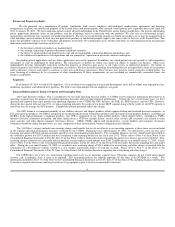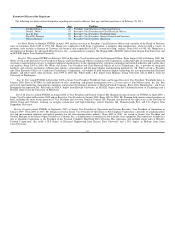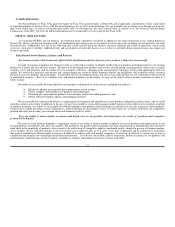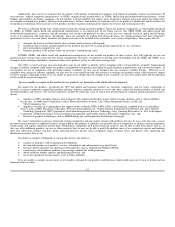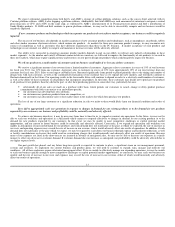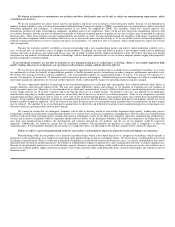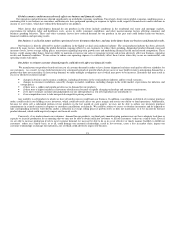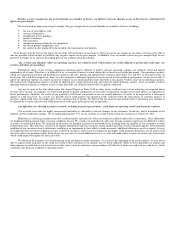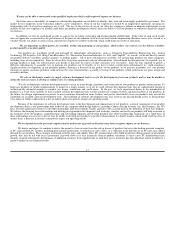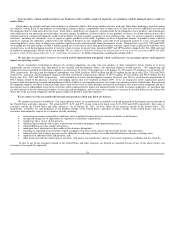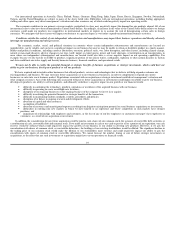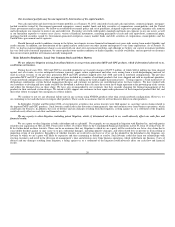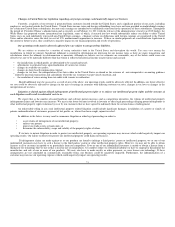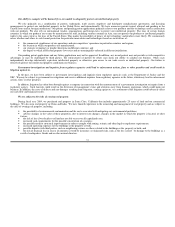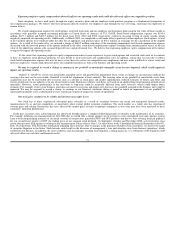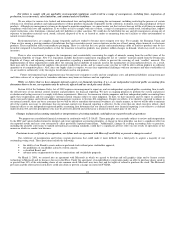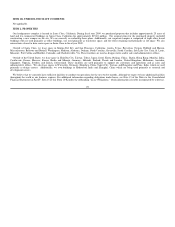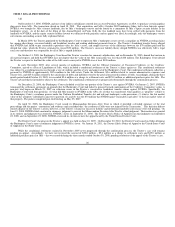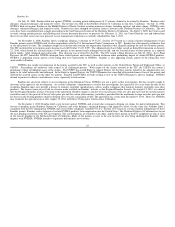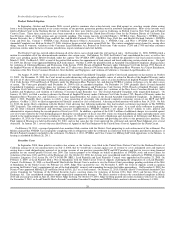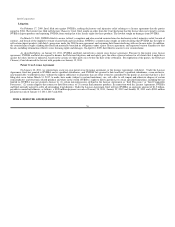NVIDIA 2011 Annual Report Download - page 21
Download and view the complete annual report
Please find page 21 of the 2011 NVIDIA annual report below. You can navigate through the pages in the report by either clicking on the pages listed below, or by using the keyword search tool below to find specific information within the annual report.
Our international operations in Australia, China, Finland, France, Germany, Hong Kong, India, Japan, Korea, Russia, Singapore, Sweden, Switzerland,
Taiwan, and the United Kingdom are subject to many of the above listed risks. Difficulties with our international operations, including finding appropriate
staffing and office space, may divert management’s attention and other resources any of which could negatively impact our operating results.
The economic conditions in our primary overseas markets, particularly in Asia, may negatively impact the demand for our products abroad. All of our
international sales to date have been denominated in United States dollars. Accordingly, an increase in the value of the United States dollar relative to foreign
currencies could make our products less competitive in international markets or require us to assume the risk of denominating certain sales in foreign
currencies. We anticipate that these factors will impact our business to a greater degree as we further expand our international business activities.
Conditions outside the control of our independent subcontractors and manufacturers may impact their business operations and thereby adversely
interrupt our manufacturing and sales processes.
The economic, market, social, and political situations in countries where certain independent subcontractors and manufacturers are located are
unpredictable, can be volatile, and can have a significant impact on our business because we may be unable to obtain or distribute product in a timely manner.
Market and political conditions, including currency fluctuation, terrorism, political strife, war, labor disruption, and other factors, including climate change,
natural or man-made disasters, adverse changes in tax laws, tariff, import or export quotas, power and water shortages, or interruption in air transportation, in
areas where our independent subcontractors and manufacturers are located could also have a severe negative impact on our operating capabilities. For
example, because we rely heavily on TSMC to produce a significant portion of our silicon wafers, earthquakes, typhoons or other natural disasters in Taiwan
and Asia could limit our wafer supply and thereby harm our business, financial condition, and operational results.
We may not be able to realize the potential financial or strategic benefits of business acquisitions or strategic investments, which could hurt our
ability to grow our business, develop new products or sell our products.
We have acquired and invested in other businesses that offered products, services and technologies that we believe will help expand or enhance our
existing products and business. We may enter into future acquisitions of, or investments in, businesses, in order to complement or expand our current
businesses or enter into a new business market. Negotiations associated with an acquisition or strategic investment could divert management’s attention and
other company resources. Any of the following risks associated with past or future acquisitions or investments could impair our ability to grow our business,
develop new products, our ability to sell our products, and ultimately could have a negative impact on our growth or our financial results:
• difficulty in combining the technology, products, operations or workforce of the acquired business with our business;
• difficulty in operating in a new or multiple new locations;
• disruption of our ongoing businesses or the ongoing business of the company we invest in or acquire;
• difficulty in realizing the potential financial or strategic benefits of the transaction;
• difficulty in maintaining uniform standards, controls, procedures and policies;
• disruption of or delays in ongoing research and development efforts;
• diversion of capital and other resources;
• assumption of liabilities;
• diversion of resources and unanticipated expenses resulting from litigation arising from potential or actual business acquisitions or investments;
• difficulties in entering into new markets in which we have limited or no experience and where competitors in such markets have stronger
positions; and
• impairment of relationships with employees and customers, or the loss of any of our key employees or customers our target’s key employees or
customers, as a result of our acquisition or investment.
In addition, the consideration for any future acquisition could be paid in cash, shares of our common stock, the issuance of convertible debt securities or
a combination of cash, convertible debt and common stock. If we make an investment in cash or use cash to pay for all or a portion of an acquisition, our cash
reserves would be reduced which could negatively impact the growth of our business or our ability to develop new products. However, if we pay the
consideration with shares of common stock, or convertible debentures, the holdings of our existing stockholders would be diluted. The significant decline in
the trading price of our common stock would make the dilution to our stockholders more extreme and could negatively impact our ability to pay the
consideration with shares of common stock or convertible debentures. We cannot forecast the number, timing or size of future strategic investments or
acquisitions, or the effect that any such investments or acquisitions might have on our operations or financial results.
19


